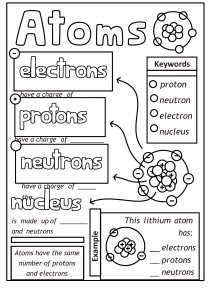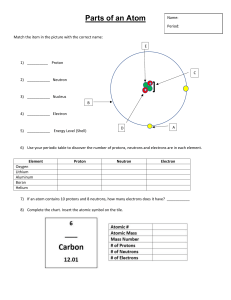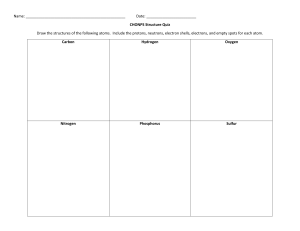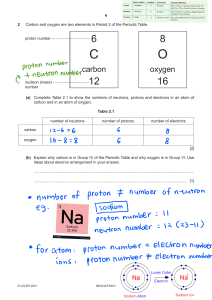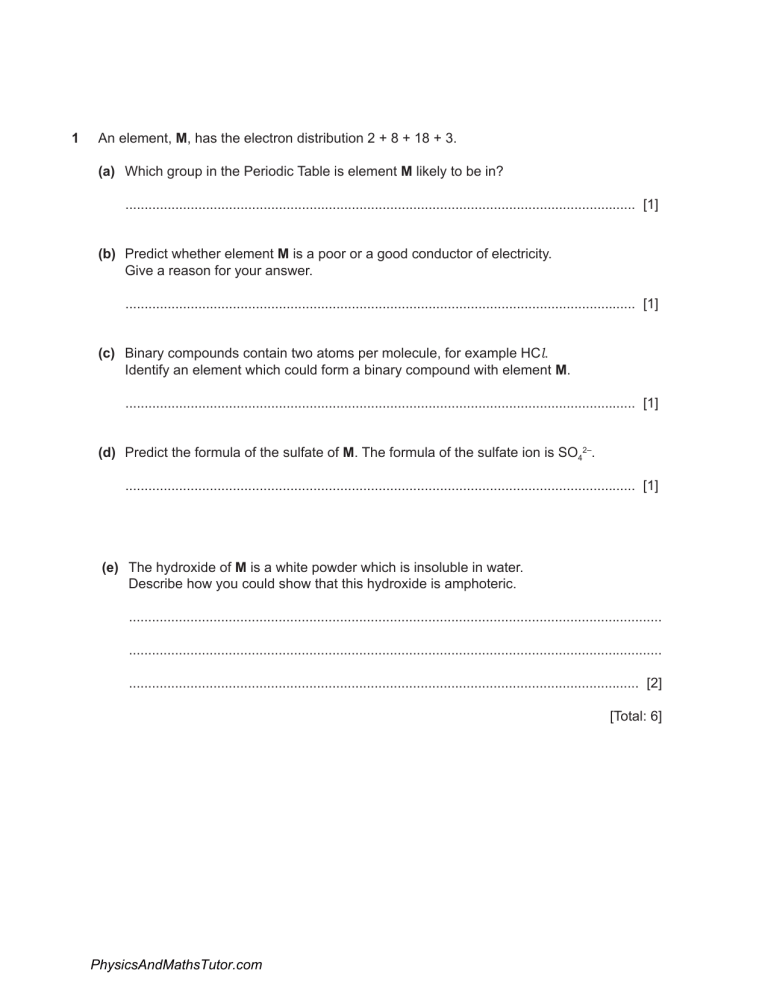
1 An element, M, has the electron distribution 2 + 8 + 18 + 3. (a) Which group in the Periodic Table is element M likely to be in? ..................................................................................................................................... [1] (b) Predict whether element M is a poor or a good conductor of electricity. Give a reason for your answer. ..................................................................................................................................... [1] (c) Binary compounds contain two atoms per molecule, for example HCl. Identify an element which could form a binary compound with element M. ..................................................................................................................................... [1] (d) Predict the formula of the sulfate of M. The formula of the sulfate ion is SO42–. ..................................................................................................................................... [1] (e) The hydroxide of M is a white powder which is insoluble in water. Describe how you could show that this hydroxide is amphoteric. ........................................................................................................................................... ........................................................................................................................................... ..................................................................................................................................... [2] [Total: 6] PhysicsAndMathsTutor.com 2 (a) The table below gives the number of protons, neutrons and electrons in atoms or ions. Complete the table. The first line is given as an example. You will need to use the Periodic Table. particle number of protons number of electrons number of neutrons A 4 4 5 B 19 18 20 C 30 30 35 D 8 10 8 E 31 31 39 symbol or formula 9 4 Be .................... .................... .................... .................... [6] (b) Using the data in the table, explain how you can determine whether a particle is an atom, a negative ion or a positive ion. ........................................................................................................................................... ........................................................................................................................................... ..................................................................................................................................... [3] [Total: 9] PhysicsAndMathsTutor.com 3 For each of the following, name an element which matches the description. (a) It is used as a fuel in nuclear reactors. ..................................................................................................................................... [1] (b) It is the only non-metal which is a good conductor of electricity. ..................................................................................................................................... [1] (c) Inert electrodes are made from this metal. ..................................................................................................................................... [1] (d) This gaseous element is used to fill balloons in preference to hydrogen. ..................................................................................................................................... [1] (e) An element which can form an ion of the type X3–. ..................................................................................................................................... [1] (f) It has the same electron distribution as the calcium ion, Ca2+. ..................................................................................................................................... [1] (g) The element is in Period 5 and Group VI. ..................................................................................................................................... [1] [Total: 7] PhysicsAndMathsTutor.com 4 The halogens are a collection of diatomic non-metals in Group VII. (a) a) Define the term diatomic. .............................................................................................................................. [1] (ii) What do the electron distributions of the halogens have in common? .............................................................................................................................. [1] (iii) How do their electron distributions differ? .............................................................................................................................. [1] (iv) Complete the table. halogen solid, liquid or gas at room temperature colour chlorine ......................................... ......................................... bromine ......................................... ......................................... iodine ......................................... ......................................... [2] (b) The halogens react with other non-metals to form covalent compounds. Draw a diagram which shows the arrangement of the valency electrons in one molecule of the covalent compound arsenic trifluoride. The electron distribution of an arsenic atom is 2 + 8 + 18 + 5. Use x to represent an electron from an arsenic atom. Use o to represent an electron from a fluorine atom. [3] PhysicsAndMathsTutor.com (c) Photochromic glass is used in sunglasses. In bright light, the glass darkens reducing the amount of light reaching the eye. When the light is less bright, the glass becomes colourless increasing the amount of light reaching the eye. Photochromic glass contains very small amounts of the halides silver(I) chloride and copper(I) chloride. The reaction between these two chlorides is photochemical. AgCl + CuCl colourless colourless Ag + CuCl 2 black colourless How does photochromic glass work? ........................................................................................................................................... ........................................................................................................................................... ..................................................................................................................................... [3] [Total: 11] PhysicsAndMathsTutor.com 5 Zirconium (Zr) is a metal in Period 5. Its main oxidation state is +4. (a) The following are all zirconium atoms: 91 90 40 Zr , 40 Zr and 92 40 Zr . In terms of numbers of electrons, neutrons and protons, how are these three atoms the same and how are they different? They are the same because ............................................................................................. ........................................................................................................................................... They are different because ............................................................................................... ..................................................................................................................................... [3] (b) Containers for fuel rods in nuclear reactors are made of zirconium. Nuclear reactors are used to produce energy and to make radioactive isotopes. (i) Which isotope of a different element is used as a fuel in nuclear reactors? .............................................................................................................................. [1] (ii) State one medical and one industrial use of radioactive isotopes. .................................................................................................................................... .............................................................................................................................. [2] (iii) Above 900 °C, zirconium reacts with water to form zirconium(IV) oxide, ZrO2, and hydrogen. Write an equation for this reaction. .............................................................................................................................. [2] (iv) In a nuclear accident, water may come in contact with very hot zirconium. Explain why the presence of hydrogen inside the reactor greatly increases the danger of the accident. .............................................................................................................................. [1] (c) It is possible to determine whether zirconium(IV) oxide is acidic, neutral, basic or amphoteric using an acid and an alkali. Complete the table of possible results. If the oxide is predicted to react write ‘R’, if it is predicted not to react write ‘NR’. if the oxide is predicted result with hydrochloric acid predicted result with aqueous sodium hydroxide acidic neutral basic amphoteric [4] PhysicsAndMathsTutor.com [Total: 13] 6 Three of the halogens in Group VII are listed below. chlorine bromine iodine (a) a) How does their colour change down the Group? .............................................................................................................................. [1] (ii) How do their melting points and boiling points change down the Group? .............................................................................................................................. [1] (iii) Predict the colour and physical state (solid, liquid or gas) of astatine, At. colour ......................................................................................................................... physical state ....................................................................................................... [2] (b) A radioactive isotope of iodine, 131 53 I, is used to treat cancer. (i) Define the term isotope. .................................................................................................................................... .............................................................................................................................. [2] (ii) How many protons, electrons and neutrons are there in one atom of 131 53 I? number of protons .............. number of electrons ............ number of neutrons ............ [2] (iii) When this isotope, 131 53 I, emits radiation, a different element with a proton number of 54 is formed. What is the name of this element? .............................................................................................................................. [1] (c) Fluorine, the most reactive halogen, forms compounds with the other halogens. It forms two compounds with bromine. Deduce their formulae from the following information. compound 1 The mass of one mole of this compound is 137 g. Its formula is ................................. [1] compound 2 0.02 moles of this compound contain 0.02 moles of bromine atoms and 0.1 moles of fluorine atoms. Its formula is ................................. PhysicsAndMathsTutor.com [1] [Total: 11] 7 The table gives the composition of three particles. particle number of protons number of electrons number of neutrons A 15 15 16 B 15 18 16 C 15 15 17 (a) What is the evidence in the table for each of the following? (i) Particle A is an atom. .................................................................................................................................... .............................................................................................................................. [1] (ii) They are all particles of the same element. .................................................................................................................................... .............................................................................................................................. [1] (iii) Particle B is a negative ion. .................................................................................................................................... .............................................................................................................................. [2] (iv) Particles A and C are isotopes. .................................................................................................................................... .............................................................................................................................. [2] (b) (i) What is the electronic structure of particle A? .............................................................................................................................. [1] (ii) What is the valency of the element? .............................................................................................................................. [1] (iii) Is the element a metal or a non-metal? Give a reason for your choice. .................................................................................................................................... .............................................................................................................................. [1] [Total: 9] PhysicsAndMathsTutor.com


